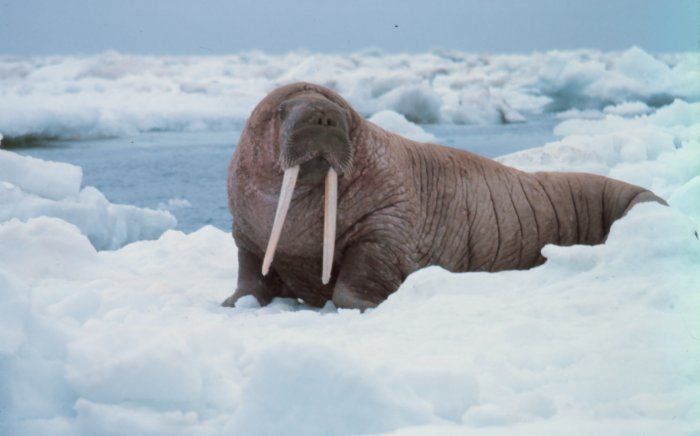Published in the Ocean Watch column, Honolulu Star-Advertiser © Susan Scott
October 4, 2010
The walruses have landed. That’s the recent news from the North Pacific, where a shortage of sea ice drove tens of thousands of these marine mammals to a shoreline near Point Lay, Alaska. There the animals, all females and pups, lie packed together so closely that some pups must lie on their mothers’ backs to avoid getting squashed. Why, I wondered, would walruses pile up on a beach like that? For that matter, why do it on ice?

It’s their nature. Walruses are among the world’s most social marine mammals, swimming and hauling out together year-round in herds of hundreds or even thousands of individuals. These herds are like fraternities and sororities. Males and females are separate, as are pregnant females from those with pups and those in estrus, that is, in heat. And when large testosterone-loaded males are around during breeding season, younger, smaller males stick to themselves or regret it.
The world’s walruses live around the Arctic Circle in both the Atlantic and Pacific oceans. Walruses head south each winter, preferring to be near the southern edge of the pack ice. During this migration, when a herd of fertile females hauls out on an ice floe to rest, ardent bulls court them from the water, whistling and clacking their teeth at the surface and making clicking and bell-clanging sounds below.
If a female likes what she hears, she leaves her floe and swims to the lucky male. Mating takes place underwater.
One male attends each herd of estrous females, ranging in number from one to about 20. Courting bulls stay from 20 to 30 feet apart in the water. If one gets overexcited and strays too close to his neighbor, a violent fight breaks out. Such clashes can cause serious injuries because, well, look at those teeth.
Walrus tusks are canine teeth that would put any vampire to shame. Most tusks are about 16 inches long, but in the largest males they can grow to 35 inches.
Besides weapons, walrus tusks are handy for life in the Arctic. Both males and females use their tusks to poke air holes in overhead ice. The tusks also help the animals hoist their 1- to 2-ton bodies onto floes.
From this toothy boost comes the walrus’s scientific name, Odobenus rosmarus, from Greek and Latin words meaning “tooth-walking sea horse.” The common name walrus is the English version of the Danish word “hvalros,” meaning “sea horse” or “sea cow.”
Walruses’ favorite foods are clams. Using their sensitive whiskers, walruses find clams and other invertebrates on the ocean floor, usually diving from 30 to 165 feet for their meals. Walruses can dive to 300 feet when necessary.
Once a walrus finds some food, it either waves a foreflipper to uncover the meal or sucks water into its mouth and squirts it out in a jet, exposing the bivalves. An adult walrus can consume from 2,000 to 3,000 clams in a single feeding session, and usually eats twice a day. Walruses don’t crush or chew their food; they suck the animals right out of their shells.
The only walrus I have ever seen was at SeaWorld in Orlando, Fla. When I stopped at the underwater window of the walrus tank, the walrus there swam to the glass, made eye contact with me and waved with a front flipper. She liked me!
OK, this individual was in a show and had been taught to wave at people. Still, that didn’t spoil the thrill. I may not have been special to the walrus, but seeing that friendly, mustachioed face up close sure was special to me.
Point Lay, Alaska, is so remote that few people will see the mass of walruses currently resting there. In fact, given their range, few people will ever see a walrus in the wild at all. After meeting that one in Florida, though, I live in hope.